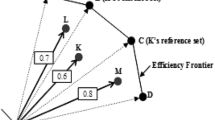Abstract
The zero weights in data envelopment analysis evaluation causes some problems such as ignoring the some inputs and/or outputs of DMUs under evaluation. Moreover, some authors claimed that the great differences in weights might be a problem. The aim of this paper is to extend the multiplier bound approach to avoid zero weights and great differences in the values of multipliers more. We show that our proposed model is equivalent to the type I assurance region model that will be used in the evaluation efficiency.
Similar content being viewed by others
References
Charnes, A., Cooper, W.W., Rodes, E.: Measuring the efficiency of decision making units. Eur. J. Oper. Res. 2(6), 429–444 (1978)
Banker, R.D., Charnes, A., Cooper, W.W.: Some models for estimating technical and scale inefficiencies in data envelopment analysis. Manag. Sci. 30, 1078–1092 (1984)
Cooper, W.W., Seiford, L.M., Tone, K.: Data Envelopment Analysis: A Comprehensive Text with Models, Applications, References and DEA-Solver Software, 2nd edn. Springer, New York (2007)
Sun, J., Yang, R., Ji, X., Wu, J.: Evaluation of decision-making units based on the weight-optimized DEA model. Kybernetika 53(2), 244–262 (2017)
Golany, B.: A note on including ordinal relations among multipliers in DEA. Manag. Sci. 34, 1029–1033 (1988)
Thompson, R.G., Langemeier, L., Lee, C., Lee, E., Thrall, R.: The role of multiplier bounds inefficiency analysis with application to Kansas farming. J. Econom. 46, 93–108 (1990)
Podinovski, V.V.: Production trade-offs and weight restrictions in data envelopment analysis. J. Oper. Res. Soc. 55, 1311–1322 (2004)
Hatami-Marbini, A., Rostamy-Malkhalifeh, M., Agrell, P.J., Tavana, M., Mohammadi, F.: Extended symmetric and asymmetric weight assignment methods in data envelopment analysis. Comput. Ind. Eng. 87, 621–631 (2015)
Dimitrov, S., Sutton, W.: Promoting symmetric weight selection in data envelopment analysis: a penalty function approach. Eur. J. Oper. Res. 200(1), 281–288 (2010)
Patel, G.N., Bose, A.: Seeking alternative DEA benchmarks. OPSEARCH 51(1), 23–35 (2014)
Ramón, N., Ruiz, J.L., Sirvent, I.: A multiplier bound approach to assess relative efficiency in DEA without slacks. Eur. J. Oper. Res. 203(1), 261–269 (2010)
Charnes, A., Cooper, W.W., Thrall, R.M.: A structure for classifying and characterizing efficiency and inefficiency in data envelopment analysis. J. Prod. Anal. 2, 197–237 (1991)
Charnes, A., Cooper, W.W.: Programming with linear fractional functional. Naval Res. Logist. Q. 9, 181–185 (1962)
Author information
Authors and Affiliations
Corresponding author
Additional information
Publisher's Note
Springer Nature remains neutral with regard to jurisdictional claims in published maps and institutional affiliations.
Appendix: Computational aspects
Appendix: Computational aspects
The objective function and constraints of the model (6) are fractional and linear, respectively. With the following change of variables (see Charnes and Cooper [13]); the model (6) converted to the LP model (11) whose optimal value is the same to the (6):
Rights and permissions
About this article
Cite this article
Akbarian, D. Avoiding dissimilarity between the weights of the optimal DEA solutions. OPSEARCH 57, 364–375 (2020). https://doi.org/10.1007/s12597-019-00392-1
Accepted:
Published:
Issue Date:
DOI: https://doi.org/10.1007/s12597-019-00392-1




